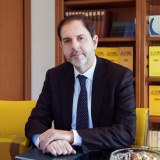
 Alberto Improda
Alberto Improda
Italian design: Gaetano Pesce between Wonder and Change
- WTI Magazine #174 Apr 20, 2024
-

 Alberto Improda
Alberto Improda
On April 4, 2024, Gaetano Pesce passed away at his home in New York. The celebrated designer was born in La Spezia (Liguria) on November 8, 1939, and studied architecture at IUAV in Venice, at the time when personalities such as Carlo Scarpa, Franco Albini, Ernesto Nathan Rogers and Bruno Zevi were teaching there.
In 1959, together with other young artists from the Serenissima, he founded Gruppo N with Milena Vettori, which experimented with optical-kinetic research.
After archiving the brief but significant collective experience, Gaetano Pesce nurtured his own original artistic and professional path, which led him to become one of the leading exponents of Radical Design.
Important for the development of his work was his meeting with Cesare Cassina, founder with Piero Busnelli of the company C&B, today B&B Italia, where he introduced the revolutionary use of highly innovative materials and solutions.
Gaetano Pesce, with his Design, his Art, his Architecture wanted to affect the lives of People and the dynamics of Society.
In extreme synthesis, it appears possible to sum up his entire poetics in two words: Wonder and Change.
Wonder brought into the eyes and hearts of Men with its astonishing forms, its disorienting colors, its unparalleled irony, and its unfailing cheerfulness.
Change introduced into the World with its irreducible battle against social injustice, cultural backwardness, mental encrustations.
We can take as an example what is considered one of his manifesto works: the UP5 armchair, also known as "Gaetano Pesce's women's armchair," a seat with pop shapes, recalling a votive fertility statuette, linked to the UP6 ottoman by a chain, evoking the ball and chain of prisoners.
The work, of great charm and innovation, also has a clear and explicit political significance, as a denunciation of the condition of women and a declaration for the protection of their rights.
It is Gaetano Pesce himself who explains that the UP5 chair "is the image of a prisoner. Women suffer because of men's prejudice. The chair had to talk about this problem."
Fulvio Irace sharply called his "a political design," "obviously polemical, thought-provoking and questioning that had to tap into the very secrets of life, far beyond the usual circuits of conception and production."
Stefano Salis, with his usual lucidity, attests that Gaetano Pesce, particularly with the work just recalled, upheld "always the 'political' priority of the body and life."
The image of the master from La Spezia between Wonder and Change echoes in the beautiful words dedicated to him by Vittorio Sgarbi: "He was the last great inventor of forms, an artist like a Trojan horse in the world of architects and designers. He believed, with his inventions, in a material as ductile as clay for God, that he could change the world. Gaetano Pesce did not answer to the powerful; he intended to help them be powerful. By his generative activity, against the gray of glass and concrete, he had colored the world with his objects and fantastic architecture. He went beyond to reach inviolate boundaries: beyond architecture. His thinking was open, and he worked with man, as if the works had body and soul. His breath."
Gaetano Pesce was undoubtedly a personality of international scope and stature.
His most significant architectural projects include the 1987 Pluralistic Tower in São Paulo, Brazil; the Organic Building in Osaka, completed in 1993, where the concept of the vertical garden is already intuited; the 1998 Bahia House in Brazil; the 2007 Pink Pavillon at Bovisa in Milan; and the 2010 "Pesce Trullo" house in Carovigno, Puglia.
His works are part of the collections of prestigious national and international museums such as the Triennale Design Museum in Milan, MoMa in New York, the Victoria and Albert Museum in London, the Centre Pompidou in Paris, the Canadian Center for Architecture in Montreal, and the Metropolitan Museum in New York.
He taught, for almost thirty years, at the Institut d'Architecture et d'Etudes Urbaines in Strasbourg, but also at Cooper Union in New York, the Polytechnic in Honk Kong, and the School of Architecture in São Paulo, Brazil.
In an interview with flashartonline.it, he had stated that this kind of nomadism appealed to him and belonged to him, as an expression of a "non-repetition," a form of training in tolerance and difference.
And yet we can say that Gaetano Pesce in the last forty years has basically lived on an ideal bridge between Italy and the United States.
In New York in 1983 he established his home and in the Big Apple he placed the headquarters of his Company, Fish Design.
He has always maintained a strong, living, deep relationship with Italy, working to the last on his activities for this year's Salone del Mobile in Milan.
Said Gaetano Pesce, "My visual language wants to create pleasure. And it is always a response to what is happening in the world. If there is a war, I have to do something, if possible, to make people laugh or smile. The only other alternative is too depressing."
We are left with, in our eyes and hearts, the Beauty and Wonder of his work.
We are left with, in our hand, the witness to continue in the Change toward a better tomorrow.